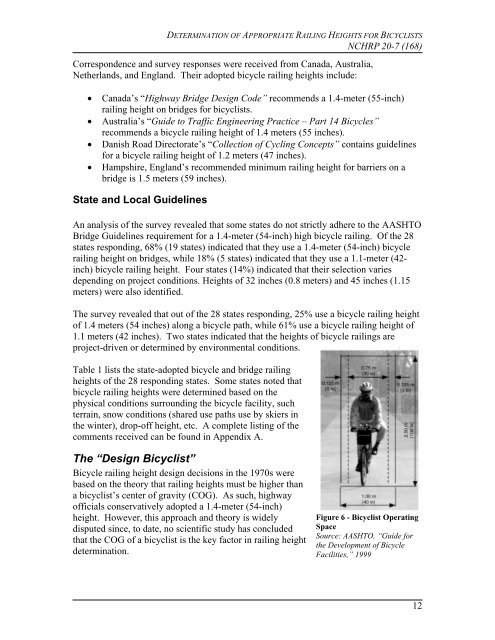Bicycle Railing Height Report - AASHTO - Subcommittee on Design
Bicycle Railing Height Report - AASHTO - Subcommittee on Design
Bicycle Railing Height Report - AASHTO - Subcommittee on Design
Create successful ePaper yourself
Turn your PDF publications into a flip-book with our unique Google optimized e-Paper software.
DETERMINATION OF APPROPRIATE RAILING HEIGHTS FOR BICYCLISTS<br />
NCHRP 20-7 (168)<br />
Corresp<strong>on</strong>dence and survey resp<strong>on</strong>ses were received from Canada, Australia,<br />
Netherlands, and England. Their adopted bicycle railing heights include:<br />
• Canada’s “Highway Bridge <strong>Design</strong> Code” recommends a 1.4-meter (55-inch)<br />
railing height <strong>on</strong> bridges for bicyclists.<br />
• Australia’s “Guide to Traffic Engineering Practice – Part 14 <str<strong>on</strong>g>Bicycle</str<strong>on</strong>g>s”<br />
recommends a bicycle railing height of 1.4 meters (55 inches).<br />
• Danish Road Directorate’s “Collecti<strong>on</strong> of Cycling C<strong>on</strong>cepts” c<strong>on</strong>tains guidelines<br />
for a bicycle railing height of 1.2 meters (47 inches).<br />
• Hampshire, England’s recommended minimum railing height for barriers <strong>on</strong> a<br />
bridge is 1.5 meters (59 inches).<br />
State and Local Guidelines<br />
An analysis of the survey revealed that some states do not strictly adhere to the <str<strong>on</strong>g>AASHTO</str<strong>on</strong>g><br />
Bridge Guidelines requirement for a 1.4-meter (54-inch) high bicycle railing. Of the 28<br />
states resp<strong>on</strong>ding, 68% (19 states) indicated that they use a 1.4-meter (54-inch) bicycle<br />
railing height <strong>on</strong> bridges, while 18% (5 states) indicated that they use a 1.1-meter (42-<br />
inch) bicycle railing height. Four states (14%) indicated that their selecti<strong>on</strong> varies<br />
depending <strong>on</strong> project c<strong>on</strong>diti<strong>on</strong>s. <str<strong>on</strong>g>Height</str<strong>on</strong>g>s of 32 inches (0.8 meters) and 45 inches (1.15<br />
meters) were also identified.<br />
The survey revealed that out of the 28 states resp<strong>on</strong>ding, 25% use a bicycle railing height<br />
of 1.4 meters (54 inches) al<strong>on</strong>g a bicycle path, while 61% use a bicycle railing height of<br />
1.1 meters (42 inches). Two states indicated that the heights of bicycle railings are<br />
project-driven or determined by envir<strong>on</strong>mental c<strong>on</strong>diti<strong>on</strong>s.<br />
Table 1 lists the state-adopted bicycle and bridge railing<br />
heights of the 28 resp<strong>on</strong>ding states. Some states noted that<br />
bicycle railing heights were determined based <strong>on</strong> the<br />
physical c<strong>on</strong>diti<strong>on</strong>s surrounding the bicycle facility, such<br />
terrain, snow c<strong>on</strong>diti<strong>on</strong>s (shared use paths use by skiers in<br />
the winter), drop-off height, etc. A complete listing of the<br />
comments received can be found in Appendix A.<br />
The “<strong>Design</strong> Bicyclist”<br />
<str<strong>on</strong>g>Bicycle</str<strong>on</strong>g> railing height design decisi<strong>on</strong>s in the 1970s were<br />
based <strong>on</strong> the theory that railing heights must be higher than<br />
a bicyclist’s center of gravity (COG). As such, highway<br />
officials c<strong>on</strong>servatively adopted a 1.4-meter (54-inch)<br />
height. However, this approach and theory is widely<br />
disputed since, to date, no scientific study has c<strong>on</strong>cluded<br />
that the COG of a bicyclist is the key factor in railing height<br />
determinati<strong>on</strong>.<br />
Figure 6 - Bicyclist Operating<br />
Space<br />
Source: <str<strong>on</strong>g>AASHTO</str<strong>on</strong>g>, “Guide for<br />
the Development of <str<strong>on</strong>g>Bicycle</str<strong>on</strong>g><br />
Facilities,” 1999<br />
12


